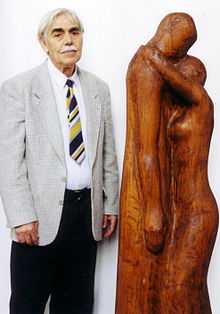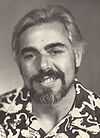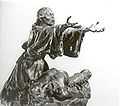Valentin Galochkin
| Valentin Galochkin | |
|---|---|
 sculptor | |
| Born |
22 November 1928 Dnipropetrovsk, Soviet Union |
| Died |
3 November 2006 Moscow, Russia |
Valentin Andreevich Galochkin (Russian: Валенти́н Андре́евич Га́лочкин) (November 22, 1928 – November 3, 2006) was a prominent Soviet (Ukrainian, Russian) sculptor.
Biography
Galochkin was born in Dnipropetrovsk (USSR) on November 22, 1928. His father Andrey Andreevich Galochkin (Russian) came from the Kaluga region and was a restaurant chef, later a modeler. Mother Olga Grigorievna Liberman (Jewish) came from the town of Chegorin (Ukraine) and worked as an accountant. Honesty and decency were of high value in the family which later shaped the sculptor's position of not supporting what he didn't hold for right.
When World War II began in 1941 the family was evacuated to the Krasnodar region, then to Uzbekistan, returning in 1944 to Dnipropetrovsk. From 1944 till 1949 Valentin Galochkin attended an art school in Dnipropetrovsk and learned from Professor Zhiradkov. From 1949 till 1955 he studied sculpture at Kiev Institute of Fine Arts. His favorite professor was Max Isaevich Gelmann.
Galochkin's graduation work "Steel smelter" (1956) was such a success, that the institute cast it in bronze and sold it to the USSR Ministry for Culture to exhibit in Lvov State Art Museum (Ukraine). Galochkin was immediately appointed head artist of Kiev sculpture works and remained at this post till 1959.
At the age of 29, Galochkin was nominated for the Lenin Prize for his work "Hiroshima" (1957); at that time this was the highest award in the USSR, however the prize went to 83-year-old Sergey Konenkov.
Very soon the young Galochkin's career came to a halt due to conflicts with the communist authorities. The sculptor refused to join the Communist Party of the USSR and actively support the soviet propaganda seeing his mission as an artist in achieving recognition regardless of his personal connections with the party leaders. Although he had to accept government's orders until 1991 for propaganda-serving monuments in Russia and the Ukraine he did his best to express general human values and reduce communist pathos.
In 1968, Valentin Galochkin won a prize in a Festival of young artists in Vienna. In 1960s and 1970s he visited the UK, France, Egypt and Greece. He was impressed by the Louvre in Paris. As he later recalled, he had so long waited to see this "temple of art" that right at the entrance, after having seen the statue of Nike of Samothrace, he couldn't help crying and for two hours didn't dare to enter the museum.

Valentin Galochkin was married three times. The first marriage in (1958) was to Yulia Ukader (Soviet, Ukrainian sculptor). A daughter from the first marriage is Tatiana Ryabokon, born Galochkina (painter). The second marriage in (1978) was to Elena Bokshitskaya (cinema-reviewer). A daughter from the second marriage is Anna Bokshitskaya (journalist). The third marriage in (1980) was to Lidia Galochkina, born Abramenko (Russian sculptor, graphic artist). Sons from the third marriage are Igor Galochkin (programmer) and Andrey Galochkin (engineer). Valentin Galochkin was a sportsman, a Master of Sports in swimming and volleyball, hunter and fisherman.
In 1986, after the Chernobyl disaster, the sculptor moved with his family from Kiev to Moscow. With the Dissolution of the USSR in 1991, as with many artists, Valentin Galochkin faced financial difficulties and for nine years had to live by selling his older works. In 1999 he emigrated to Wismar in Germany, and in 2002 moved to Hamburg. In 2002, he felt ill and had to undergo a few operations. He died from a heart attack on 3 November 2006 on a trip to Russia, in Moscow. He was buried in Nakhabino cemetery on November 8, 2006.
Artistic style
His early works, including the graduation work "Steel smelter" (1956) follow the standards of soviet realism set up by Vera Mukhina, Ivan Shadr, Sergey Merkurov.
The first significant work "Hiroshima" (1957) which made Galochkin well known in the USSR is devoted to the victims of atomic bombing of Hiroshima in World War II. "Hiroshima" expresses the sculptor's protest against nuclear weapons, a call for humanness.
-

"Steel-smelter", 1956
-

"Hiroshima", 1957
-

"V. I. Lenin", 1960
From 1957 till 1991 Galochkin produced dozens of state-ordered parade monuments and busts to Vladimir Lenin and other soviet leaders. However the sculptor never treated these works as art. Already as a young artist he became disillusioned with the principles of soviet realism. He studied European and American art, especially Henry Moore, Ossip Zadkine, Amedeo Modigliani.
A series of monuments by Galochkin is devoted to World War II. His view of war is however very far from the one of the soviet propaganda. Having survived the war as a child, he portrays the suffering of common people instead of youthfully marching soldiers or triumphant military leaders.
His work "Leaving for the front" 1957, carved from one piece of wood, shows the last passionate kiss of a soldier leaving his wife. In memorial "Victim" 1964 a shape of a human appears as a breach in solid stone, as if formed by an exploding shell. The disappeared human being has left a trace, a silhouette in the air. The memorial to the victims of Babi Yar (working title "Violence") 1964 - a pregnant woman, cut in half is a terrible symbol for the mass executions of Jews. Monument "Widows" 1975 depicts an old and a young woman (mother and wife) eternally holding the soldier's helmet. In the work "Gate of sorrow" 1976 two "women are mourning over a heavy loss, like atlantes". "Memorial to the burnt village" 1979 - a girl standing in the flame.
-

"Leaving for the front", 1957
-

"Victim", 1964
-

"Babi Yar", 1964
-

"Widows", 1975
-

"Gate of sorrow", 1976
-

"Memorial to the burnt village", 1976
A common theme of Galochkin's indoor sculpture is the figure of a woman and female torso. Unfortunately most of his studies and works depicting the female body in a realistic manner did not survive to the present day. His presentation of the nude body gradually changed from a realistic to more and more a symbolic one. In works "Queen" 1965, "River" 1970, "Cellist" 1975 the figure of a woman is stylized, converted into a play of silhouettes, volumes, and "shapes of air". Valentin Galochkin develops his own concept of sculpture as a multitude of silhouettes, which are built by the air surrounding the sculpture. From different angles of view the same sculpture makes a different silhouette.
-

"Mermaid", 1975
-

Study ("Slavery"), 1965
-

Study ("Spring"), 1975
-

"Queen", 1965
-

"River", 1970
-

"Cellist", 1975
A special place in Galochkin's works belongs to the geometrical form of ellipse in which he sees the basis of composition and "the drive to harmony". His "Torsos" of 1969 and 1975 convert female torsos into ellipse-reminding, strained and balanced shapes.
-

"Bounded torso", 1969
-

"Torso", 1975
-

"Torsos", 1975
Citations (from working notes)
Even beautiful but designed and therefore annoying rhythms and silhouettes are also lies, a make-up, so empty and distant.
Only pationless can have a quality of the eternal.
If there is an objective concept of "beauty" and if beautiful, in this case, should remain forever beautiful, one should create in accordance with the laws of the universe.
Not preciocity makes a work of art timeless and great, but its naked, sincere truth and purity, so simple as the earth itself, faceup opened to people.
What does this beauty of a thing consist of? Perhaps, first of all, of harmony and inner rhythm and cohesion, rationality and hidden appropriateness.
For your inner world to become valuable to others, not to yourself only, it must be humane.
In a piece of art there must be a mystery.
Bibliography
- Галочкина Л.Н. Валентин Галочкин: жизнь и работа скульптора. Из рабочих записей Валентина Галочкина. 2010, Москва, Анкил, 336 с. с илл., ISBN 9785864763049.
External links
| Wikimedia Commons has media related to Valentin Galochkin. |
|